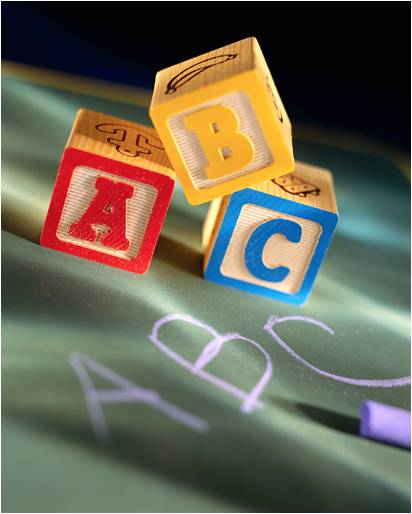Phonological Dyslexia
Quick Facts about Phonological Dyslexia
- The most common type of dyslexia, synonymous with dyslexia itself
- Characterized by an inability to sound out words, especially nonsense words
- Associated with the classic symptoms of dyslexia
- A brain based disorder, caused by a neurological processing problem
- An auditory processing problem more so than visual
- Typically developmental (genetic/inherited) but in some cases can be an acquired type from stroke or Alzheimer's disease
Definition

Phonological dyslexia is extreme difficulty reading that is a result of phonological impairment, meaning the ability to manipulate the basic sounds of language. The individual sounds of language become 'sticky', unable to be broken apart and manipulated easily.
This type of dyslexia is synonymous with dyslexia itself. See our What is Dyslexia page for more information.
Cause
The cause is believed to stem from a difference in brain areas associated with processing the sounds of language. Phonologic dyslexics are tapping brain regions which are less efficient at processing phonemes and recognizing words by sight in comparison to efficient readers. Over the past two decades breakthroughs in brain scanning and neuroscience have provided ongoing support for this hypothesis regarding the cause of dyslexia.
Unfortunately, the phonological problem alone does not account for the many symptoms of dyslexia unrelated to phonetic decoding
difficulties, including short-term memory problems, difficulty with balance and fine motor skill, common in dyslexic children - symptoms that contribute to dysgraphia and dyspraxia. In short, the root cause of dyslexia remains unknown.
Implications for Treatment
The best documented methods for teaching a student with phonological dyslexia are largely based on principles of the Orton-Gillingham approach to reading that was developed in the 1930's by Samuel Torrey Orton and Anna Gillingham.
Their approach includes the following six elements:
1) Personalized: Teaching begins with recognizing the differing needs of learners.
2) Multisensory: Involve regular interaction between the teacher and the
student and the simultaneous use of multiple senses including auditory, visual,
and kinesthetic (touch). For example, a
dyslexic learner is taught to see the letter A, say its name and sound and
write it in the air – all at the same time. The use of multisensory input is
thought to enhance memory storage and retrieval.
3) Structured, Systematic, Sequential, and Cumulative: Language elements and rules are introduced in a linguistically logical, understandable order. Students go back to the very beginning of their language learning, to lay a proper foundation.
Beginning by reading and writing sounds in isolation
(phonemes), then blending sounds into syllables and words. Elements of
language—consonants, vowels, digraph blends, and diphthongs are
introduced in an orderly fashion. Only later, learners proceed to advanced
structural elements such as syllable types, roots, preffixes and suffixes.
4) Cognitive: Students study the many generalizations and rules that
govern the structure of language.
5) Flexible: Instructors ensure
the learner is not simply recognising a pattern and applying it without
understanding. When confusion of a previously taught rule is discovered, it is
re-taught from the beginning.
6) Personal and Direct: Building a close teacher-student relationship
with continuous feedback and positive reinforcement leading to success and self
confidence.
For more detailed information see our page on programs that work.
Final Thoughts on Phonological Dyslexia
When people use the term dyslexia they are usually referring to the classic phonological kind, but to impress at the cocktail party you can add the adjective to be more specific. The term phonologic serves as a helpful reminder of the problem that most struggling readers have: difficulty manipulating the basic sounds of language, resulting in difficulty sounding out words.
Return to the top of Phonological Dyslexia
- Home ›
- Types of Dyslexia ›
- Phonological Dyslexia
New! Comments
Share your thoughts or ideas! Leave us a comment in the box below. You can post it at this site only or on Facebook too, it's up to you.